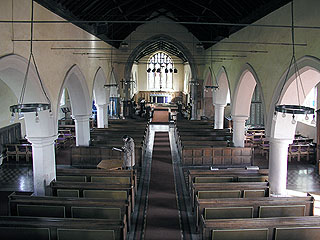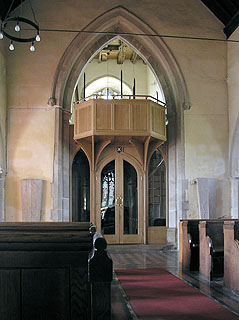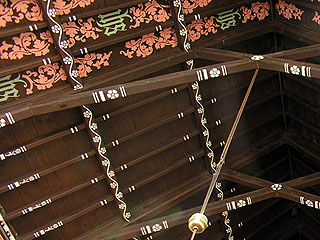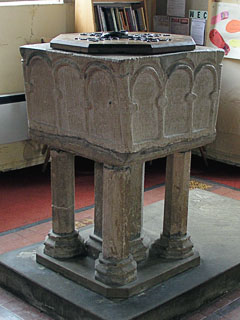St Andrew is very handsome from the outside. The north aisle has some very handsome Perpendicular windows, and the west tower has diagonal buttresses and delicate y-tracery in the bell-openings.
Externally, the body of the church looks largely perpendicular, although an early looking blocked up lancet in the south aisle suggests that this is not the whole story. Inside, the mystery of the true age of the church deepens.
The pillars in the south arcade are norman, though they've been given newer capitals and bases at some point. The northern arcade is later, with octagonal piers, but it still looks pretty old. The arches are all broad and low, and made me think it was probably Transitional (Pevsner thinks that the nave was originally an aisleless Norman building, and that the pillars and openings were cut out of this Norman wall when the first aisles were put up). The effect is all a bit odd, anyway - it is low and long, and not very elegant. There seem to be structural problems too - iron cables cross the nave and link two huge girders running above the inner walls of the aisles.
More interesting than the architecture are the fittings. The font is a square Norman bowl sitting on five octagonal pillars - on each face of the bowl is a very crudely cut blank arcade with three openings. At the east end of the north aisle, the window is flanked by two niches with little vaults: presumably this was the site of an altar to the Virgin, or perhaps a little guild-chapel.
Also in the north aisle is a stone coffin with an interesting double-caduceus design on the lid, and the remnants of the base of the rood screen. There are bits of original red and green paint on the panels and the tracery, but none of the original paintings of saints survive.
Funnily enough, my favourite things in the church were modern. Underneath the tower, they have recently built a parish room, separated from the church by a screen of pale wood and glass. Above it is the bell-ringing chamber, and this is open to the body of the nave.
A little octagonal balcony projects through the tower arch, supported by rib-vaults. I was impressed: the workmanship is good, and the design is very pleasing.
A similar thing has been done in the Early English chancel - if you can tear your gaze away from the eye-curdling roof. The beams are stained dark brown and then decorated with flowers and leaves in white, pink and mint green paint - it looks more like decorated chocolate than anything else.
The east window is nothing special - the image of St Etheldreda carrying Ely Cathedral is quite nice, I suppose - but I do like the modern wood panelling around the sanctuary. It is in the same pale wood as the work under the tower, but instead of gentle curves, here the arches are sharp and slender. The blind arcading is elaborate and geometrical, and each arch is topped with a little wooden cross. On the southern side, there are two seats that can be folded up and hidden in amongst the shafts and arches - a rather amusing modern version of sedilia.
As we were leaving, the rain started tipping down with a vengeance. However, there was something outside that I was determined to see. Beyond the bounds of the graveyard are the graves of the 'Three Martyrs'. These were Henry Osland, Joseph Odley and Francis Holcroft, three pioneers of non-conformism in England.
All three were Cambridge-trained clergymen who refused to take the 1662 Oath of Allegiance (one of the methods used by Charles II to restore the dominance of the established Anglican Church).
All three were imprisoned in Cambridge Castle, but a sympathetic gaoler used to let them out and they would preach to thousands in secret. Holcroft alone is said to have established thirty churches in South Cambridgeshire, mostly during the time when he was supposedly in prison.
The graves are through a gate in the northeast corner of the churchyard and then along a little alley, passing between peoples' gardens. Sitting almost in the middle of someone's vegetable patch is a little enclosure surrounded by iron railings, and in the middle are three simple chest tombs commemorating the three.
I stood under the trees, looking out at the neat lawns and the well-tended soil, and I thought: it is good that these three fathers of English non-conformism should rest in this beautiful garden, surrounded by blackbirds and cabbages and the soft spring rain.
St Andrew was open when we visited, and the Three Martyrs' Graves are always accessible.




